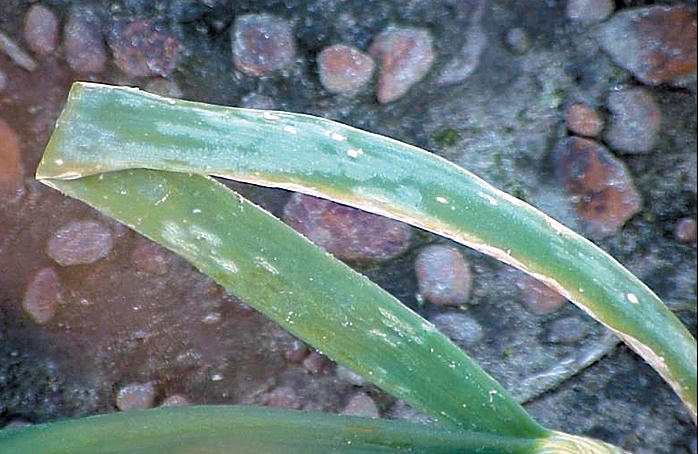Managing Center Rot, Botrytis Leaf Blight of Onions in Georgia
By Bhabesh Dutta, Department of Plant Pathology, University of Georgia
New research at the University of Georgia could help onion growers better manage bacterial diseases while also reducing expenses and increasing profits.
Vidalia sweet onion is a specialty vegetable crop that accounts for 40 percent of the national spring onion production and had an annual farm-gate value of $148 million in 2016.
Center rot is the most damaging bacterial disease affecting onions in Georgia, with severe losses occurring both in the field and in storage. Since its first report in Georgia in 1997, center rot has been a constant threat to onion producers in Georgia and other onion producing states. Based on crop-loss estimates in 2016, center rot resulted in $3.5 million in losses in Georgia.
The disease is primarily caused by a Gram-negative bacterium, Pantoea ananatis, which is endemic to Georgia, as more than 20 weed species have been reported as possible inoculum reservoirs. Other Pantoea species such as P. agglomerans and P. alli can also cause center rot symptoms, and all three bacterial species have been reported in Georgia.
Center rot symptoms include necrotic and bleached streaks on young leaves, and in severe cases, it may lead to wilting of plants. The bacterium may also progress to the bulb and predispose bulbs to rot in storage. Under favorable conditions, the disease has potential to cause yield losses up to 100 percent. The bacterium has the potential to move from foliage to the bulb, causing rotting and liquefaction in bulb scales. P. ananatis has the ability to be seed-borne, and it is recommended that growers use clean seed to reduce potential introduction of inoculum.
Evaluating Center Rot Management
Dr. Bhabesh Dutta with the department of plant pathology at the University of Georgia evaluated and identified susceptible growth stages of onion that can cause bulb infection. He also evaluated if there are differences in susceptibility to bulb infection among sweet onion cultivars. Dutta identified two cultivars, 1518 and 1407, with significantly lower bulb incidence compared to others. Furthermore, Dutta identified three susceptible growth stages in onion that can cause bulb incidence in field as well as in storage.
As a follow-up study, Dutta protected these susceptible growth stages with Kocide 3000 (copper bactericide) or a plant defense inducer (Actigard). Dutta observed that protective treatments with Kocide 3000 or Kocide 3000+Actigard at bulb initiation and bulb swelling growth stages significantly reduced bulb incidence of center rot. In contrast, applications of Kocide 3000 or Actigard, or Kocide 3000 + Actigard did not significantly reduce bulb incidence after onion seedlings were exposed to thrips, indicating that thrips infestation can reduce the efficacy of protective chemical treatments against P. ananatis.
In a field study, Dutta evaluated the onion growth stage-directed chemical applications on center rot incidence in onion bulbs. Onion plants were protected with Kocide 3000 or Actigard, or Kocide 3000 + Actigard at all three growth stages (first leaf senescence, bulb initiation and bulb swelling). The field plots were aggressively protected with insecticides for thrips control. Dutta observed that Kocide 3000 and Kocide 3000+ Actigard, when applied at either bulb initiation or bulb swelling stage, resulted in significantly lower disease incidence in bulbs compared to Actigard only and the untreated control. Marketable yield was also significantly higher when Kocide 3000 and Kocide 3000 with Actigard were applied at the bulb initiation and bulb swelling stages.
Dutta has demonstrated that growth stage-based targeted spray under good thrips control settings can reduce the frequency of copper sprays by at least three applications, which may account for $300-350/acre in savings for Georgia onion growers.

Botrytis leaf blight lesions appear as small, sunken, light tan areas surrounded by pale green tissue or “ghost halos.” Photo courtesy David Langston
Improving Botrytis Leaf Blight Management
Botrytis leaf blight, caused by a fungal pathogen, Botrytis squamosa, has been a continued threat to onion growers in Georgia. The disease is commonly managed by late-season fungicide applications. However, the level of disease control varies year to year and field to field.
In a multi-year study from 2015 to 2017, Dutta demonstrated that early-season overhead Fontelis application can significantly improve the efficacy of late-season fungicides against Botrytis leaf blight. The new fungicide recommendation was extended to the onion growers that included one application of a SDHI fungicide: Fontelis or Endura or Merivon at 10 days after transplanting followed by late-season fungicide sprays comprising of Scala, Inspire Super, Pristine, Bravo, Luna Tranquility and Omega 500.
The current recommendation may result in a $2,000/acre increase in profit. Based on a recent survey with county agents, the adoption rate of this recommendation in 2018 is 40 percent, and in coming years, it is expected to be widely adopted by Georgia onion growers.

